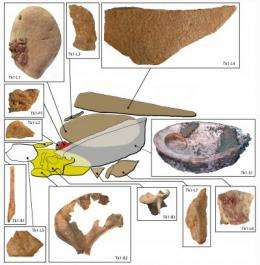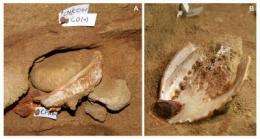100,000-year-old ochre toolkit and workshop discovered in South Africa

An ochre-rich mixture, possibly used for decoration, painting and skin protection 100,000 years ago, and stored in two abalone shells, was discovered at Blombos Cave in Cape Town, South Africa.
"Ochre may have been applied with symbolic intent as decoration on bodies and clothing during the Middle Stone Age," says Professor Christopher Henshilwood from the Institute for Human Evolution at the University of the Witwatersrand, Johannesburg, who together with his international team discovered a processing workshop in 2008 where a liquefied ochre-rich mixture was produced.
The findings will be published in the journal Science tomorrow.
The two coeval, spatially associated toolkits were discovered in situ (not been moved from its original place of deposition) and the kits included ochre, bone, charcoal, grindstones and hammerstones. The grinding and scraping of ochre to produce a powder for use as a pigment was common practice in Africa and the Near East only after about 100,000 years ago.
"This discovery represents an important benchmark in the evolution of complex human cognition (mental processes) in that it shows that humans had the conceptual ability to source, combine and store substances that were then possibly used to enhance their social practices," explains Henshilwood.

"We believe that the manufacturing process involved the rubbing of pieces of ochre on quartzite slabs to produce a fine red powder. Ochre chips were crushed with quartz, quartzite and silcrete hammerstones/grinders and combined with heated crushed, mammal-bone, charcoal, stone chips and a liquid, which was then introduced to the abalone shells and gently stirred. A bone was probably used to stir the mixture and to transfer some of the mixture out of the shell."
The quartz sediments in which the ochre containers were buried were dated to about 100,000 years using Optically Stimulated Luminescence (OSL) dating. This is consistent with the thermoluminescence dating of burnt lithics and the dating of calcium carbonate concretions using uranium-series dating methods.
"The recovery of these toolkits adds evidence for early technological and behavioural developments associated with humans and documents their deliberate planning, production and curation of pigmented compound and the use of containers. It also demonstrates that humans had an elementary knowledge of chemistry and the ability for long-term planning 100,000 years ago," concludes Henshilwood.
The two specimens will be on display at the Iziko Museum in Cape Town from Friday, 14 October 2011.
Provided by University of the Witwatersrand




















